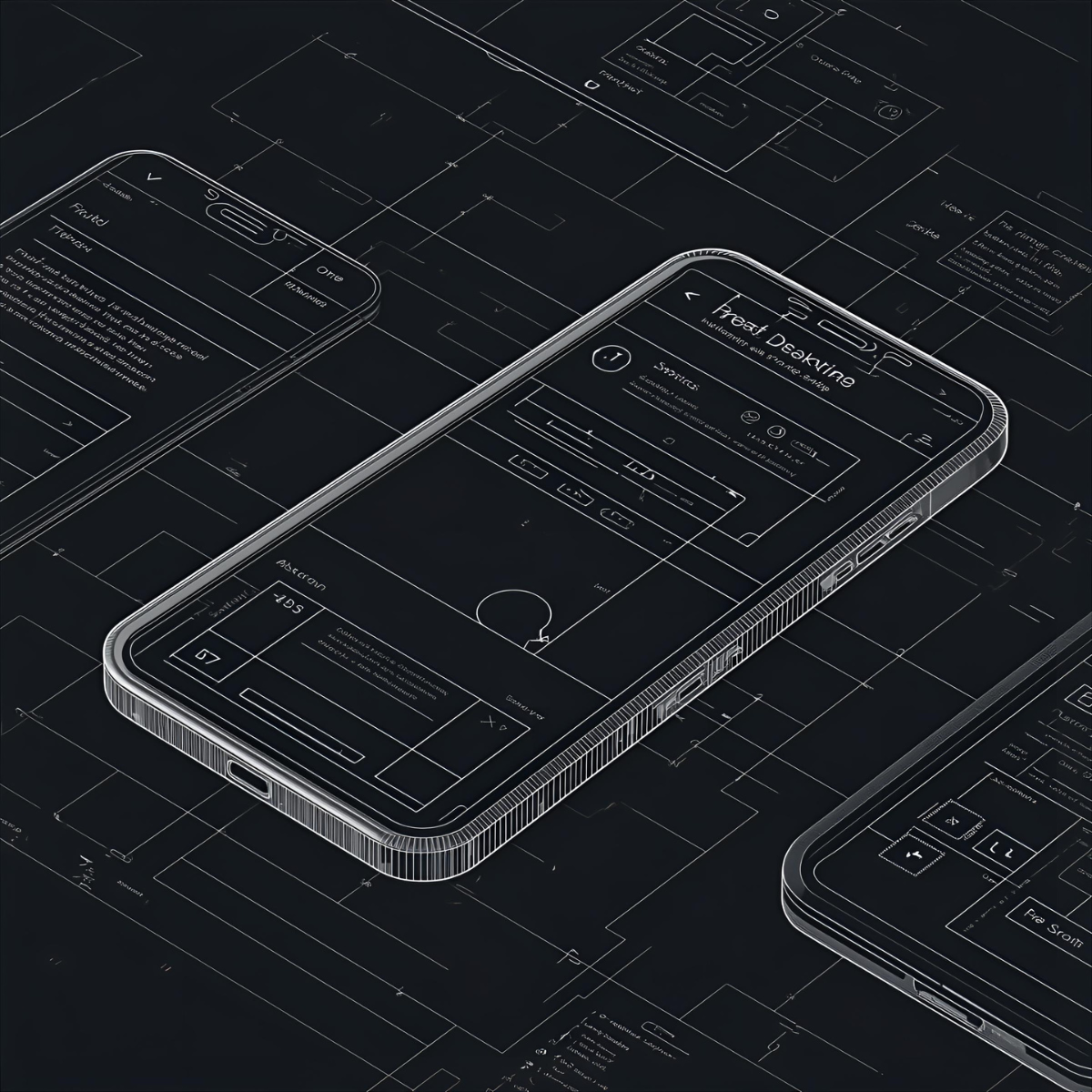
Introduction
iOS UX design has become the cornerstone of modern mobile app success. In a world where user expectations have never been higher, people don’t just want apps that work, they want experiences that feel fast, intuitive, and effortless. This is where thoughtful design takes center stage.
Unlike UI (which focuses on how an app looks), UX defines how it feels, how quickly users can move through tasks, how clear each action is, and how enjoyable the overall journey becomes. For iOS apps, where Apple’s design ecosystem already sets a high bar, delivering an exceptional user journey means blending aesthetics, speed, and empathy in equal measure.
At Uverse Digital, we believe great UX isn’t just about usability, it’s about emotional flow. Whether you’re designing a mobile banking platform, a game, or an immersive XR experience, understanding how users think and move through your app is critical. Great UX doesn’t happen by accident, it’s the result of a structured approach that prioritizes performance, clarity, and continuous feedback.
This blog explores exactly how to achieve that. You’ll find a practical iOS UX design checklist, best practices for user journey design in mobile, and insights from real-world design processes to help you craft seamless, high-retention experiences.
Why UX & User Journeys Matter in iOS Design
When users download an app from the App Store, they expect it to “just work.” Anything less, confusing layouts, slow screens, or extra taps, can lead to instant uninstalls. That’s why UX design is not just a creative step; it’s a business-critical process.
The iOS Standard: Intuitive and Effortless
Apple’s ecosystem is built around one promise, simplicity. Every touch, swipe, and gesture must feel natural. Following Apple’s Human Interface Guidelines helps developers design apps that align with this expectation while maintaining brand uniqueness.
At Uverse Digital, our design process takes those guidelines as a foundation, then adds user behavior analytics, cognitive design principles, and latency optimization to turn that foundation into a differentiated brand experience.
From Clicks to Connections
A mobile user journey isn’t about clicks or screens; it’s about emotional flow. Users should never have to think about what comes next, the app should anticipate it. Whether it’s onboarding, navigation, or micro-interactions, each touchpoint must be consistent and context-aware.
Business Impact of Great UX
Investing in iOS UX design directly impacts engagement, retention, and revenue. A study by Forrester found that every dollar invested in UX brings up to $100 in return. For startups and enterprises alike, UX isn’t optional, it’s the key differentiator that turns casual users into loyal advocates.
The iOS UX Design Framework Checklist
Building a seamless user experience for iOS apps requires more than beautiful screens. It demands a framework-driven approach, one that balances creativity with consistency, and aesthetics with performance.
Below is a structured UX design checklist to guide every phase of your iOS project, the same structured process Uverse Digital uses to craft high-performance, visually engaging apps.
1. Research & Discovery
Before you wireframe, research your users.
- Identify audience needs, motivations, and frustrations.
- Analyze competitor apps for UX gaps and opportunities.
- Define clear goals for what success looks like in your user journey design.
Use tools like Hotjar, UXCam, or direct playtesting to gather real behavioral data, not assumptions.
2. Information Architecture (IA)
A great UX starts with logical flow.
- Map out navigation hierarchies.
- Keep menus simple and intuitive.
- Follow Apple’s convention: clarity > creativity.
Users expect consistency, deviating too far from standard iOS patterns can cause confusion.
3. Wireframing & Prototyping
Sketch, test, refine, before writing a single line of code.
- Use tools like Figma or Sketch for quick iterations.
- Test micro-interactions (swipes, long-presses, animations).
- Simulate low-latency interactions for real-world performance testing, a standard step in Uverse’s QA cycle.
4. Visual Design
Visuals should elevate usability, not distract from it.
- Stick to Apple’s Human Interface Guidelines for spacing, typography, and iconography.
- Use contrast and color intentionally to guide attention.
- Prioritize accessibility (Dynamic Type, VoiceOver support).
Good visual design doesn’t shout; it subtly directs, something Uverse’s designers live by when balancing art direction and usability.
5. Performance Optimization
A beautiful app that lags is still a bad experience.
- Optimize images, animations, and API calls.
- Design for low latency, speed is UX.
- Continuously test across iPhone models and iOS versions.
At Uverse, we integrate performance testing into every sprint to ensure design and code deliver equal speed.
6. Continuous Feedback Loop
UX design doesn’t end at launch.
- Collect real-time analytics and feedback.
- Monitor drop-off points in the user journey.
- Iterate frequently, small improvements drive long-term loyalty.
Common Mistakes to Avoid in iOS UX Design
Even experienced designers sometimes fall into the trap of over-designing or under-testing. To deliver a truly exceptional iOS user experience, avoid these common pitfalls, insights drawn from Uverse’s real-world design projects.
1. Ignoring Platform Conventions
Trying to reinvent every element might look creative, but it often breaks the iOS experience users expect. Avoid unnecessary custom gestures, hidden menus, or unfamiliar icons.
Follow Apple’s design language, it builds trust and familiarity.
2. Overloading with Features
Cramming too many features into your app can overwhelm users and complicate navigation.
Focus on your app’s core journey, do one thing exceptionally well before expanding.
3. Neglecting Performance
Animations, transitions, and 3D visuals are engaging, until they lag.
Low-latency design should always be a top priority. Test across devices and optimize for real-world usage.
4. Inconsistent Visual Hierarchy
When buttons, fonts, or icons lack consistency, users hesitate.
Maintain alignment, spacing, and visual rhythm across screens to make navigation intuitive.
5. Skipping User Testing
Assumptions can kill good UX.
Test prototypes early with real users, their feedback will reveal usability issues you may never notice internally.
6. Ignoring Accessibility
Accessibility isn’t optional.
Support VoiceOver, dynamic font sizing, and color contrast standards to ensure your app works for everyone.
Best Practices for Exceptional iOS User Journeys
Delivering great UX is both an art and a science. While frameworks and checklists guide the process, what truly separates average from exceptional is how you translate real user behavior into design logic.
These best practices reflect the philosophy behind Uverse Digital’s design ethos, performance-led, human-centered, and insight-driven.
1. Design for Micro-Moments
Modern users interact with apps in seconds, not minutes. The best iOS UX captures attention immediately.
Revolut’s quick-glance dashboard shows users their balance and transactions within a single tap, reducing cognitive load and boosting retention.
Focus on reducing friction in the first 10 seconds of user interaction.
2. Make Onboarding Effortless
Your app’s first impression decides its lifespan.
Duolingo uses gamified onboarding, no long forms, just one-tap setup and instant progress tracking.
Best Practice: Offer contextual hints instead of lengthy tutorials. Teach through interaction, not instruction.
3. Prioritize Low Latency
Every millisecond counts in mobile UX. Lag is one of the fastest ways to lose users.
Insight (from Uverse’s dev team): Apple’s design team emphasizes “responsiveness as feedback.” Every tap should trigger an immediate, visible reaction, even if it’s just a subtle animation or haptic cue.
Use lightweight frameworks and preloading techniques to ensure fluid transitions and instant feedback loops.
4. Build Emotion into Design
Great iOS UX doesn’t just work, it feels right.
Airbnb’s UI creates emotional trust through calming colors, rounded typography, and reassuring microcopy (“You’re in good hands”).
Combine empathy-driven design with motion and tone to create confidence and delight.
5. Create a Continuous Feedback System
Top apps evolve through user data and A/B testing.
Spotify runs iterative UX experiments weekly to track feature usability and emotional engagement.
Best Practice: Integrate in-app feedback widgets and analytics dashboards to capture friction points in real time.
6. Respect Apple’s Design DNA
Consistency with Apple’s Human Interface Guidelines keeps your app native and trustworthy.
Apple’s principles, clarity, depth, and deference, ensure every user journey feels natural and device-native.
Instead of mimicking Android layouts, optimize your app for iOS gestures, layout grids, and typography hierarchy.
FAQs: iOS UX Design & User Journeys
1. What makes iOS UX design different from Android UX design?
iOS design emphasizes simplicity, clarity, and responsiveness. Apple’s Human Interface Guidelines create a unified experience across all devices, while Android allows more customization and flexibility. iOS UX success depends on consistency and micro-interactions.
2. How can I improve the user journey in my iOS app?
Map every user touchpoint, from onboarding to exit. Identify friction points, simplify flows, and ensure low-latency performance. Testing prototypes with real users helps you refine the journey based on actual behavior, not assumptions.
3. What tools are best for iOS UX design?
Top tools include Figma, Sketch, and Adobe XD for wireframing and prototyping; UXCam or Hotjar for behavior analytics; and TestFlight for pre-launch testing within Apple’s ecosystem.
4. How important is speed in iOS UX design?
Extremely. Studies show that a one-second delay in app responsiveness can reduce conversions by 7%. In iOS UX, low latency equals high engagement. Optimize assets, streamline transitions, and test performance across devices.
5. What are the key principles of Apple’s UX design?
Apple’s Human Interface Guidelines center around three principles:
- Clarity: Every element serves a purpose.
- Deference: Content takes priority over interface.
- Depth: Motion and layering create context and hierarchy.
Conclusion: Designing iOS Experiences That Stay With Users
Exceptional iOS UX design is about more than visuals, it’s about creating an emotional rhythm users feel throughout their journey. The best apps don’t make people think; they make people flow.
From intuitive onboarding to lightning-fast interactions, every touchpoint matters. Apple’s design ecosystem rewards clarity, simplicity, and speed, and when your app embodies those principles, users notice.
At Uverse Digital, we design iOS experiences that merge creativity with precision. Our multidisciplinary teams of designers, developers, and UX researchers work together to build high-performance, emotionally engaging apps that users love, and keep using.
Whether you’re a startup designing your first MVP or an enterprise redefining your mobile strategy, remember:
Great UX isn’t built once, it’s refined continuously.
Let’s create iOS experiences that inspire loyalty, drive performance, and set new industry standards.
👉 Partner with Uverse Digital to design the next generation of user-centered mobile experiences. Explore our UX & Development Services.
About the author : Uverse Digital
Stay Ahead of the Game
Get XR insights, dev tips, and industry updates straight to your inbox
Join our insider list for cutting-edge content on game development, performance optimization, and immersive experiences — curated for industry leaders like you.



